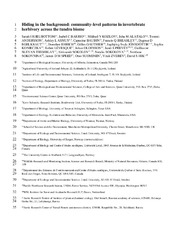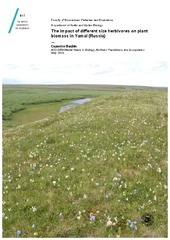Rheubottom, Sarah I.; Barrio, Isabel C.; Kozlov, Mikhail V.; Alatalo, Juha M.; Andersson, Tommi; Asmus, Ashley L.; Baubin, Capucine; Brearley, Francis Q.; Egelkraut, Dagmar; Ehrich, Dorothee; Gauthier, Gilles; Jonsdottir, Ingibjørg; Konieczka, Sophia; Lévesque, Esther; Olofsson, Johan; Prevéy, Janet S.; Slevan-Tremblay, Guillaume; Sokolov, Aleksandr; Sokolova, Natalia; Sokovnina, Svetlana; Speed, James David Mervyn; Suominen, Otso; Zverev, Vitali; Hik, David S. (Journal article; Tidsskriftartikkel; Peer reviewed, 2019-09-03)
Invertebrate herbivores depend on external temperature for growth and metabolism. Continued warming in tundra ecosystems is proposed to result in increased invertebrate herbivory. However, empirical data about how current levels of invertebrate herbivory vary across the Arctic is limited and generally restricted to a single host plant or a small group of species, so predicting future change remains ...


 English
English norsk
norsk
